Choosing the right rowing machine for your home gym can be a perplexing task. With the market offering a variety of resistance types, the most prominent being water and air rowers, it’s essential to understand their differences and similarities.
Both offer a comprehensive full-body workout, burning calories and improving cardiovascular health, yet they do so through distinct mechanisms and with varying features that could sway your preference.
Understanding the nuances between water and air rowers is key to selecting a machine that aligns with your workout needs and preferences. While they share some commonalities in the muscle groups they target and the general technique used, aspects such as price, storage convenience, noise level, and the technology provided through their monitors vary.
Key Takeaways
- Water and air rowers offer different resistance mechanisms, each with unique benefits for a full-body workout.
- Price, noise level, and tech features like monitors can influence your choice between a water or air rowing machine.
- Both types of rowers engage the same muscle groups using similar rowing techniques despite their operational differences.
Water Rowing Machine
Resistance Operation
Your water rower provides unique resistance through the interaction between the paddles and water in the tank stationed at the front. When you pull the handle, it rotates the paddles through the water, generating drag.
The intensity of your workout increases directly with your pace—the quicker you row, the more the resistance. It’s that simple: the harder you row, the more force you need to exert.
Water Level Adjustment
Adjusting the water level in your rowing machine’s tank doesn’t increase resistance; rather, it changes the “weight” of your simulated boat.
More water equals a heavier feel, akin to moving a bulkier boat through the water. This gives a more strength-oriented workout. Your machine will come with a manual describing how to adjust the water level based on your preferences and physical capacity.
Monitors
Expect a functional and straightforward monitor with your water rowing machine. While not as advanced as some air rower monitors, the top-tier option like WaterRower’s Series 4 (S4) features various metrics like stroke rate, distance, and heart rate.
Furthermore, it allows for a connection to a PC, offering gaming and worldwide competition connectivity. Ideal for home use, this monitor should satisfy most of your tracking needs unless you are aiming for competitive rowing benchmarks.
Other Features
Apart from the resistance, water rowers offer a myriad of other appealing traits:
- The Sound: The water rower creates a soft, rhythmic sound as you row, which many find calming—a sharp contrast to the often louder air rowers.
- Aesthetics: Boasting a wooden frame, water rowers can blend seamlessly into your home decor, doubling as a piece of furniture.
- Upright Storage: Save space with the easy-to-store design, with the water tank ensuring the machine remains stable when stored upright.
- Strap vs. Chain: A strap is utilized instead of a chain for a quieter experience, reducing noise and making TV watching or conversations undisturbed.
- Build Quality: The wooden construction not only looks good but also serves to dampen noise and vibration, enhancing the feel and durability of your machine.
Air Rowing Machine
Resistance Operation
As you row faster on an air rowing machine, the spinning flywheel creates more air resistance. This variable resistance means the harder you pull, the more the air particles push back against the flywheel, providing a dynamic workout.
Your own efforts determine the resistance level, thanks to the rule of cubes which creates an exponential relationship between your rowing speed and the resistance you feel.
Damper Setting
Adjust the damper on your air rower to alter the “feel” of your stroke, similar to changing gears on a bicycle. Settings range from 1, for a light and easy stroke, up to 10 for a more intense, heavy rowing experience.
While the setting doesn’t change the resistance, it does modify the amount of air interacting with the fan, altering the feel of your row. As you move the damper to a higher setting, you’ll notice your strokes feeling similar to rowing a heavier boat.
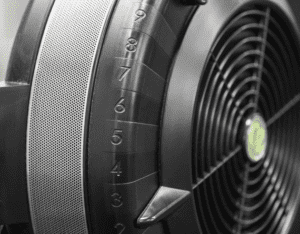
Monitors
The enjoyment of tracking workout data comes from the advanced monitors found on high-end air rowers. Take the Concept2 RowErg PM5 monitor, acclaimed for its precision in tracking distance, speed, power, and more. Its live drag factor recording compensates for environmental variances, so you get consistent data.
Whether it’s a casual row or a competitive sprint, rest assured, your performance is measured accurately, allowing you to even virtually compete with rowers worldwide.
Other Features
Other practical aspects of air rowers include:
- Folding seat rails for a reduced footprint and easier storage.
- Lighter overall machine weight due to the plastic flywheel design.
- Noticeable “whooshing” sound with each stroke — a heads-up if you’re rowing around others or need to keep the noise down.
With these features, air rowing machines hold their own as a top choice for home workouts, suiting a range of preferences and fitness goals.
Water vs. Air Rowing Machine
Similarities
Understanding the common ground between water and air rowing machines will help you recognize that regardless of your choice, you’re embarking on an effective fitness journey. Here’s what they share:
- Frame and Size: Both types have long frames and sizable footprints, suiting even tall users.
- Weight Capacity: Sturdy design accommodates heavy users, with some models supporting 300+ lbs.
- Variable Resistance: Experience variable resistance with both; the harder you row, the greater the resistance.
- Suitability for HIIT: Thanks to the variable resistance, both machines are excellent for HIIT workouts.
- On-Water Feel: Both aim to recreate the resistance of rowing on actual water.
- Customization: Adjust the rowing stroke feel by adding or subtracting water, or modifying the damper settings.
- Technique: The rowing technique does not change; it remains consistent across both machine types.
- Mechanism: Both operate with a handle connected to a rowing strap or chain.
- Muscle Engagement: The same muscle groups are targeted, ensuring a full-body workout.
- Industry Reputation: Both water and air rowers are highly regarded in the fitness community.
Differences
While the basic premise of rowing machines is the same, there are key features that set water and air rowers apart, affecting your workout experience.
- Price:
- Water rowers generally start at a higher price of around $700, with premium models upward of $1,100.
- Air rowers cover a vast price range from $300 to $1,000+, making them more accessible to different budgets.
- Noise Level:
- Water rowers offer a quieter, often soothing experience with the sounds of water splashing.
- Air rowers generate a distinct “whooshing” noise from the fan, louder and potentially disruptive (although some also find it meditative).
- Monitor Quality:
- Water rowers have advanced monitors, but air rowers can boast the top-tier, most accurate monitors, ideal for tracking data and performance.
- Stroke Feel:
- Water rowers provide a strong catch followed by a lighter finish, emphasizing the initial force applied.
- Air rowers give a gentle catch with increasing resistance towards the finish, changing the dynamics of the stroke.
- Aesthetics and Design:
- Water rowers, particularly those with wooden frames, blend into home décor, offering a pleasing aesthetic.
- Air rowers tend to have a more industrial look, resembling traditional gym equipment.
- Storage:
- Water rowers usually have an upright storage position, often with wheels for easy movement.
- Air rowers may offer a foldable design, also with wheels, for convenience and space-saving.
- Weight:
- Water rowers tend to be heavier due to their water tanks, influencing the smoothness of the rowing experience.
- Air rowers can be lightweight, depending on the construction materials used.
If you’re in the market for a rowing machine, understanding these nuances can be critical in shaping your decision. Reflect on your personal preferences and practical needs such as space, storage, and the calming aspect of exercise.
Whether you prioritize a meditative, aesthetic, and soothing workout or a robust, data-driven session with advanced monitoring, there’s a rowing machine tailored to your lifestyle.
Differences in Noise Level
When considering the noise levels between air and water rowers, here’s what you need to know:
- Air Rowers: On average, these machines produce about 70 decibels of noise, comparable to the loudness of street traffic.
- Water Rowers: These are generally quieter, emitting around 63 decibels, akin to normal conversation levels.
The difference is due to the mechanisms each machine uses to create resistance. Air rowers create a constant whirring sound as the flywheel spins, while water rowers generate a softer sloshing from the water tank. If a low noise level during your workouts is a priority, you might prefer the gentle whoosh of the water rower over the more pronounced sound of the air rower.
For a closer look at the acoustic differences, watch the video below, which includes sound demonstrations of various rowing machines, including magnetic models.
Final Thoughts
Selecting between water and air rowing machines is a matter of personal preference, aligning with your workout needs. Here’s some guidance to help with your decision:
For Racing and Training Enthusiasts: Air rowing machines are ideal for tracking progress and pushing competitive boundaries.
Concept2 RowErg Indoor Rowing Machine with PM5 Monitor
4.9
The world’s best-selling rowing machine. Adjustable air resistance & easy storage. Comes with a device holder for your smartphone. You can’t go wrong with this rowing machine.
- Best overall rowing machine on the market
- Connects with heart rate monitors
- 5 year frame warranty
- Fan can be too noisy for some
- Not the cheapest
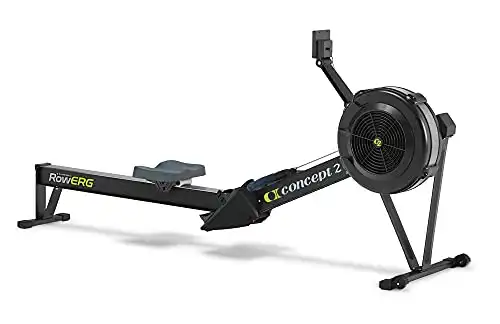
We earn a commission if you make a purchase, at no additional cost to you.
For a Quieter, More Natural Experience: Water rowing machines provide the soothing sound of water, perfect for a tranquil workout environment.
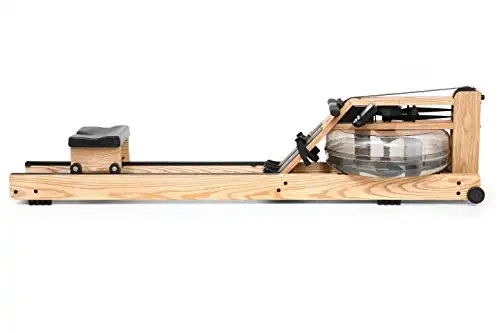
Looking for a Budget-Friendly Option? Stamina Air Rower 1399 is an affordable air rower without compromising on quality.
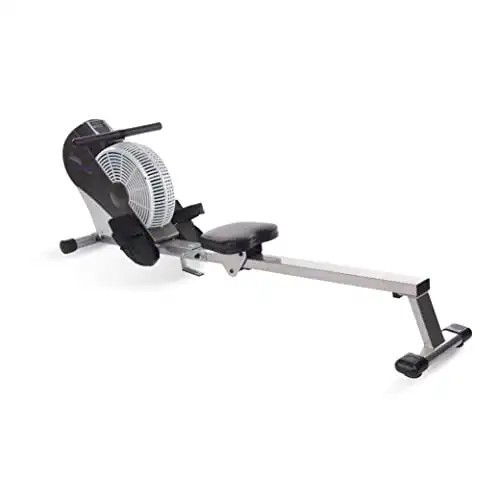
Side-by-Side Comparisons: Compare features and prices of different models to find your match. View the comparison chart.
Your ideal rowing machine should fit effortlessly into your life, offering either the lively dynamic of a race or the calmness of a serene river – the choice is all yours.
Enjoy your rowing journey, and feel free to share your experiences or questions; they’re always welcome!
Frequently Asked Questions
What are the primary differences between water and air rowing machines?
- Resistance Mechanism: Water rowers use a water tank and paddles to create resistance, emulating the feel of rowing on water. Air rowers generate resistance through a flywheel with fan blades; the resistance adjusts with your rowing intensity.
- Noise Level: Air rowers tend to be noisier due to the spinning of the flywheel. Water rowers are generally quieter, offering a gentle swooshing sound.
- Maintenance: Water rowers require occasional water tank treatment to keep the water clean. Air rowers need minimal maintenance, usually just keeping the fan and chain or belt clean.
How does the resistance feel compare between water rowers and air rowers?
With water rowers, you’ll feel a smooth, consistent resistance at the beginning of each stroke that closely mimics the dynamics of rowing on water.
On an air rower, the resistance is more dynamic, with a lighter feel at the start and increasing as you pull harder, potentially providing a more challenging workout as your speed increases.
What are the benefits of using a water rowing machine?
- Realistic Rowing Sensation: The resistance from the water gives a true-to-life rowing feel.
- Aesthetic and Sound: Water rowers often have a sleek, wooden frame and provide a soothing water sound that adds to the experience.
- Consistent Resistance: Offers a consistent pull throughout the stroke, ideal for a rhythmic workout.
Which type of rowing machine offers the most realistic rowing experience?
Water rowing machines are typically known for delivering a rowing experience that’s closest to actual water rowing due to the natural resistance created by the water in the tank.

Rowing Machine King Founder and Author.

 АРХИВ
АРХИВ БОКС И ЕДИНОБОРСТВА
БОКС И ЕДИНОБОРСТВА Игровые виды спорта
Игровые виды спорта КАРДИОТРЕНАЖЕРЫ
КАРДИОТРЕНАЖЕРЫ МАССАЖНОЕ ОБОРУДОВАНИЕ
МАССАЖНОЕ ОБОРУДОВАНИЕ МЕДИЦИНА РЕАБИЛИТАЦИЯ
МЕДИЦИНА РЕАБИЛИТАЦИЯ СВОБОДНЫЕ ВЕСА
СВОБОДНЫЕ ВЕСА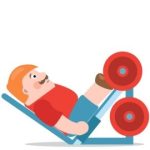 СИЛОВЫЕ ТРЕНАЖЕРЫ
СИЛОВЫЕ ТРЕНАЖЕРЫ Соревновательное оборудование
Соревновательное оборудование СПОРТ ДЛЯ ДЕТЕЙ
СПОРТ ДЛЯ ДЕТЕЙ СПОРТИВНОЕ ПИТАНИЕ И АКСЕССУАРЫ
СПОРТИВНОЕ ПИТАНИЕ И АКСЕССУАРЫ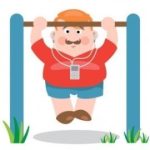 УЛИЧНЫЕ ТРЕНАЖЕРЫ
УЛИЧНЫЕ ТРЕНАЖЕРЫ ФИТНЕС И АЭРОБИКА
ФИТНЕС И АЭРОБИКА